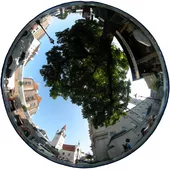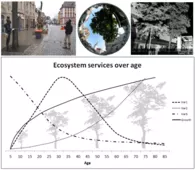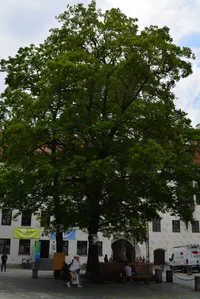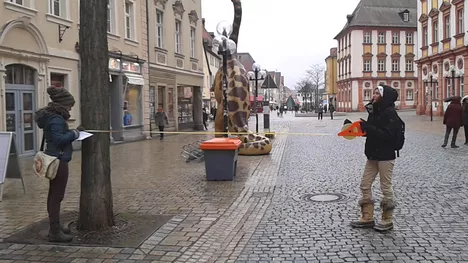SP8: Urban Trees



Head: Prof. Dr. Dr. Hans Pretzsch, Prof. Dr. Richard L. Peters
Affiliated Post-Doc: Dr. Torben Hilmers
Affiliated PhD Student: Martin Honold
Background

Urban trees with their manifold ESS and functions offer a means for providing sustainable solutions to climate mitigation and adaptation to environmental, societal and economic challenges. By improving the knowledge about the structure, functioning, and sustainable management of urban trees this project aims at better exploitation of the potential of urban trees for climate-smart urban planning. Our overarching objective is to acquire empirical knowledge about the structure, functioning, and ESS of Urban Trees, and to integrate this knowledge in spatially explicit modeling, and sustainable management of urban tree stocks.
Objectives
For this purpose, we will:
(O1) Review and model selected ESS (cooling, shading, C-sequestration, habitat provision, noise reduction) of urban trees depending on site, species and age;
(O2) Quantify urban tree mortality as essential knowledge gap for modeling and planning;
(O3) Analyze the interaction between adjacent urban trees (in situ and experiments) as this paves the way to innovative planting and arrangement designs;
(O4) Create a matrix model for sustainable planning of stocks of urban trees;
(O5) Put a special emphasis on tall and old urban trees, their growth and ESS, as old trees play an essential role for NBS and are under-represented in research so far.
The overarching hypotheses of this project are that:
(H1) ESS provision of urban trees is highly dependent on their site-conditions, creating a need for specific urban tree management plans reducing mortality and including interactions;
(H2) The potential of urban trees for climate-smart sustainable urban planning can be significantly improved by the knowledge-based design of urban tree stocks.

Execution: Leila Parhizgar
Dissertation: Knowledge-based design of urban tree stock and related ecosystem service provision.
Methods:
To meet the objectives the set of urban trees ESS will be reviewed (and to some extent measured at experimental sites in Munich), quantified and modeled depending on tree size/age, environmental conditions, competition, and facilitation. The resulting regression models may be implemented in a spatially explicit model for urban trees. Mortality will be analyzed and modeled species-specific by logistic regressions based on urban tree records of selected cities including Munich. The tree–tree interactions will be studied at mature trees in the city of Munich and also in pot experiments with common tree species and species assemblages. Further, we will develop a spatially explicit model for sustainable management of urban trees, analogously to the concept of sustainable forestry developed by von Carlowitz. The main drivers of the model will be species-specific tree diameter growth functions and mortality rates. By auxiliary relations, ESS such as biomass, carbon stock, or cooling can be estimated. A given state of an urban tree stock can be assessed by a set of sustainability indicators regarding its distance from a target stock. As old and tall trees provide large portions and unique aspects to ESS and as they were somehow under-represented by urban tree research so far, we will pay attention to them by our empirical and model work. The empirical and the modeling part of this project will cover the following indicators at the individual tree level but also (by modeling and up-scaling) at the quarter level: Indicators for human well-being (in cooperation with SP9 and SP12), climate smartness in terms of mitigation and adaptation (SP2, SP5, and SP6), water regulation (SP10 and SP13), pollution reduction (SP7 and SP9), and habitat and biodiversity provision (SP1).
Outlook:
Period I will yield a model prototype for spatial explicit modeling and analyzing urban tree structure, functioning, and ESS. Based on this, we will further develop, validate, and apply this model for multicriteria scenario analysis for assessment, planning, and sustainable management of urban tree stocks in Period II.
Execution: Sierra Quinn McKinney
As climate change accelerates, trees in urban environments are increasingly exposed to atmospheric drought due to the rising vapor pressure deficit (VPD). This environmental shift forces trees to close their stomata in an attempt to conserve water and avoid lethal embolisms. In urban areas, this stress is further intensified by the urban heat island effect and increased salinity, which makes it crucial to understand species-specific stress thresholds.
The halting of transpiration as a result of stomatal closure not only impacts the health of urban trees but also diminishes their ability to provide critical ecosystem services, such as microclimatic temperature regulation. Cities, therefore, need to determine when targeted irrigation is required to sustain tree health and ensure the continuation of these ecosystem services.
This project seeks to develop near-real-time monitoring methods for transpiration rates to assess drought stress in urban trees and identify irrigation needs. The following key research questions will guide the project:
How is water use regulated in urban trees during drought periods?
Which ecophysiological measurements can provide near-real-time insights into the drought stress experienced by specific tree species?
Can we develop a predictive model to identify periods when irrigation will support both transpiration and tree growth?
Intended Methods:
In this project, you will collect data from multiple tree species across the city of Munich. Utilizing state-of-the-art automated sap flow sensors, specifically the heat-ratio method, you will accurately quantify transpiration at sub-hourly resolutions. This data, combined with local meteorological information, will enable precise identification of periods when stomatal closure occurs, signalling the onset of drought stress.
A unique aspect of this project is the use of novel dendrometer sensors, which are capable of recording both drought stress and growth signals. In addition, weekly branch sampling will be conducted to measure leaf water potential—a critical indicator of drought stress—and assess the risks of lethal embolisms in the trees. This comprehensive dataset will allow for the precise determination of drought stress periods across species.
Finally, these ecophysiological measurements will support the development and application of a mechanistic model capable of continuously simulating drought stress in urban trees. This model will help inform irrigation strategies tailored to different species, ensuring the maintenance of valuable ecosystem services provided by these urban trees.